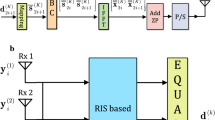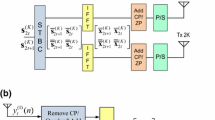Abstract
This paper presents blind channel estimation for downlink W-CDMA system that employs chaotic codes and Walsh codes for spreading information bits of the multiple users. In a W-CDMA system, while transmitting over multipath channels, both intersymbol interference (ISI) as a result of Inter Chip Interference and multiple access interference (MAI) cannot be easily eliminated. Although it is possible to design multiuser detectors that suppress MAI and ISI, these detectors often require explicit knowledge of at least the desired users’ signature waveform. Earlier work focused on a subspace based channel estimation algorithm for asynchronous CDMA systems to estimate the multiple users’ symbols, where only AWGN channel was considered. In our work, we study a similar subspace-based signature waveform estimation algorithm for downlink W-CDMA systems, which use chaotic codes instead of pseudo random codes, that provide estimates of the multiuser channel by exploiting structural information of the data output at the base station. In particular, we show that the subspace of the (data+noise) matrix contains sufficient information for unique determination of channels, and hence, the signature waveforms and signal constellation. We consider Rayleigh and Rician fading channel model to quantify the multipath channel effects. Performance measures like bit error rate and root mean square error are plotted for both chaotic codes and Walsh codes under Rayleigh and Rician fading channels.
Similar content being viewed by others
References
Simon M. K., Omura J. K., Scholtz R. A., Levitt B. K. (1994) Spread Spectrum Communications Handbook. McGraw-Hill, NY
Vitali, S., & Setti, G. (2006). Improving PA efficiency by Chaos based spreading in MC/DS_CDMA systems. In Proceedings of IEEE international symposium on circuits and systems (ISCAS) (pp. 1195–1198).
Kennedy, M. P., Kolumban, G., Kis, G., & Jako, Z. (1998). Recent advances in communicating with chaos. In Proceedings of IEEE international symposium on circuits and systems (pp. 461–464.). CA: Monterey.
Bensley S. E., Aazhang B. (1996) Subspace-based channel estimation for code division multiple access communication systems. IEEE Transactions on Communications 44(8): 1009–1020
Gaffar M. Y. A., Broadhurst A. D., Takawira F. (2005) Improved subspace-based channel estimation algorithm for DS-CDMA systems exploiting pulse-shaping information. IEEE Communication Proceedings 152(5): 533–540
Tian L., Chen F., Wei G. (2004) Blind adaptive multiuser detection based on a constrained MMSE criterion. Journal of Electronics (China) 21(4): 328–331
Khodr Saiffan A., Emad K., Hussaini A. L. (2007) Diversity reception of an asynchronous blind adaptive multiuser detector through correlated Nakagami fading channel. Wireless Personal Communications: An International Journal 40(4): 539–555
Liu D., Zare H. (2007) A multipath interference cancellation technique for WCDMA downlink receivers. International Journal of Communication systems 20(6): 661–668
Torlak M., Xu G. (1997) Blind multiuser channel estimation in asynchronous CDMA systems. IEEE Transactions on Signal Processing 45(1): 137–147
Sirbu M., Koivunen V. (2004) Delay estimation in long-code asynchronous DS-CDMA systems using multiple antennas. EURASIP Journal on Wireless Communications and Networking 2004(1): 84–97
Zhang Y., Zhang L., Liao G. (2003) Channel estimation of multi-rate DS-CDMA signals in slow fading multipath channels. Journal of Electronics (China) 20(5): 321–325
Ström, E. G., Parkvall, S., Miller, S. L., & Ottersten, B. E. (1994). Propagation delay estimation of DS-CDMA signals in a fading environment. In IEEE proceedings of global telecommunications conference (pp. 85–89), San Francisco, CA.
Talwar S., Viberg M., Paulraj A. (1994) Blind estimation of multiple co-channel digital signals, using an antenna array. IEEE Signal Processing Letters 1(2): 29–31
Brand, M. (2005). Fast low-rank modifications of the thin Singular Value Decomposition. MERL, 201 Broadway, Cambridge, MA 02139.
Yu J. L., Chieh Y. (2004) Blind estimation of finite alphabet digital signals using eigenspace-based beamforming techniques. Signal Processing Journal 84(5): 895–905
Chen X., Leyman R. A. (2007) Blind channel estimation for linearly precoded MIMO-OFDM systems. International Journal of Wireless and Optical Communications (IJWOC) 4(3): 207–220
Koivisto T., Koivunen V. (2007) Blind despreading of short-code DS-CDMA signals in asynchronous multiuser systems. Signal Processing Journal 87(11): 2560–2568
Yu J. L., Kuo C. M., Lin C. C. (2005) Blind channel estimation for MC-CDMA systems with long spreading codes. Signal Processing Journal 85(10): 1898–1906
Ye Y., Abeysekara S. S. (2006) Efficient blind estimation and equalization of non-minimum phase communications channel via the use of a zero-forcing equalizer. Signal Processing Journal 86(5): 1019–1034
Chen B. S., Huang Y. J., Chen S. C. (1998) Estimation and equalization of multipath Rician fading channels with stochastic tap coefficients. Signal Processing Journal 68(1): 43–57
Chen L. M., Chen B. S., Hou W. S. (2001) Adaptive multiuser DFE with Kalman channel estimation for DS-CDMA systems in multipath fading channels. Signal Processing Journal 81(4): 713–733
Rontogiannis A. A., Berberidis K., Marava A., Palicot J. (2005) Efficient semi-blind estimation of multipath channel estimation via a delay decoupling optimization approach. Signal Processing Journal 85(12): 2394–2411
Halunga S. V., Vizireanu D. N. (2010) Performance evaluation for conventional and MMSE multiuser detection algorithms in imperfect reception conditions. Digital Signal Processing Journal 20(1): 166–178
Halunga S. V., Vizireanu D. N., Fratu O. (2010) Imperfect cross-correlation and amplitude balance effects on conventional multiuser decoder with turbo encoding. Digital Signal Processing Journal 20(1): 191–200
Yang, B., & Lemoine, F. D. (2005). Comparison of multiuser detection techniques for asynchronous multirate DS-CDMA systems. In IEEE 16th international symposium on personal, indoor and mobile radio communications (Vol. 1, pp. 437–441), Berlin, DE.
Halunga, S. V. (2011). Performance evaluation of conventional and MMSE multiuser detection algorithms with different spreading signature codes. In EUROCON IEEE international conference on computer as a Tool (EUROCON) (Vol. 1, pp. 1–4), Lisbon.
Wu H. Y., Duel-Hallen A. (1998) Performance comparison of multiuser detectors with channel estimation for flat Rayleigh fading CDMA channels. Wireless Personal Communications 6(2): 137–160
Melvasalo M., Koivunen V. (2004) Blind channel estimation in multicode CDMA using multi-antenna receiver. Wireless Personal Communications 28(3): 163–178
Mo F., Kim J., Dave S., Kwatra S. C. (2004) Adaptive channel estimation aided log-map turbo decoder implementation for DS-CDMA based mobile systems. Wireless Personal Communications 28(3): 179–204
Rizaner A., Amca H., Hacioglu K., Ulusoy A. H. (2005) Channel estimation by using short training sequences in CDMA systems. Wireless Personal Communications 34(4): 359–371
Kaddoum, G., Roviras, D., Charge, P., & Prunarety, D. F. (2009). Performance of multiuser chaos-based DS-CDMA system over multipath channel. In IEEE international symposium on circuits and systems (ISCAS) 2009 (pp. 2637–2640).
Wang B. Y., Zheng W. X. (2006) Adaptive blind channel equalization in chaotic communications by using nonlinear prediction technique. IEEE Proceedings on Vision, Image and Signal Processing 153(6): 810–814
Lee W. C. Y. (1991) Overview of cellular CDMA. IEEE Transactions on Vehicular Technology 40(4): 291–301
Moulines E., Duhamel P., Cardoso J., Mayrargue S. (1995) Subspace methods for the blind identification of multichannel FIR filters. IEEE Transactions on Signal Processing 43(2): 516–525
Tong L., Xu G., Kailath T. (1994) Blind identification and equalization based on second-order statistics: A time domain approach. IEEE Transactions on Information Theory 40(2): 340–349
Golub G., Van Loan C. (1984) Matrix computations. John Hopkins University Press, Baltimore, MD
Rappaport T. (1996) Wireless communications—Principles and practice. Prentice Hall, Englewood Cliffs, NJ
Author information
Authors and Affiliations
Corresponding author
Rights and permissions
About this article
Cite this article
Sangeetha, M., Bhaskar, V. Performance Analysis of Subspace Based Downlink Channel Estimation for W-CDMA Systems Using Chaotic Codes. Wireless Pers Commun 71, 1–21 (2013). https://doi.org/10.1007/s11277-012-0793-1
Published:
Issue Date:
DOI: https://doi.org/10.1007/s11277-012-0793-1




